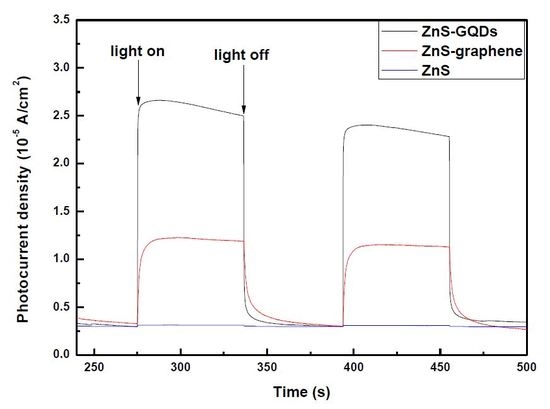Graphene Quantum Dots-ZnS Nanocomposites with Improved Photoelectric Performances
Abstract
:1. Introduction
2. Materials and Methods
2.1. Materials
2.2. Preparation of Graphite Oxide and Graphene
2.3. Preparation of GQDs
2.4. Synthesis of ZnS-GQDs Composites
2.5. Characterization
3. Results and Discussion
3.1. XRD
3.2. Morphological Characterization
3.3. UV-Vis Absorption Spectra
3.4. Transient Photocurrent Responses
3.5. Electrochemical Impedance Spectroscopy
4. Conclusions
Acknowledgments
Author Contributions
Conflicts of Interest
References
- Choi, B.; Shim, H.; Allabergenov, B.; Lee, M.J. Optical and photoelectric properties of Mn-doped ZnS thin film on a flexible indium-tin-oxide/polyethylene terephthalate substrate prepared by pulsed laser deposition. Opt. Mater. Express 2016, 6, 2336–2341. [Google Scholar] [CrossRef]
- Venkataramana, S.; Ramanaiah, K.; Sarcar, M.M.M. Studies on photo- and thermal stability of PVA-encapsulated Mn-doped ZnS nanoparticles. Appl. Phys. A Mater. 2016, 122, 292. [Google Scholar] [CrossRef]
- Gao, Y.H.; Zhang, X.F.; Wang, P.P.; Lei, Y.; Yang, X.G.; Fa, W.J.; Niu, H.L.; Zheng, Z. A novel pi-conjugated Zn←S→Zn unit interface in the ZnS-Zn(S)2L inorganic/orgainc hybrids for significant photoelectric response. Appl. Surf. Sci. 2017, 402, 336–343. [Google Scholar] [CrossRef]
- Saglam, O.; Dilgin, Y. Fabrication of Photoelectrochemical Glucose Biosensor in Flow Injection Analysis SystemUsing ZnS-CdS-Carbon Nanotube Nanocomposite Electrode. Electroanalysis 2017, 29, 1368–1376. [Google Scholar] [CrossRef]
- Kashinath, L.; Namratha, K.; Byrappa, K. Sol-gel assisted hydrothermal synthesis and characterization of hybrid ZnS-RGOnanocomposite for efficient photodegradation of dyes. J. Alloy. Compd. 2017, 695, 799–809. [Google Scholar] [CrossRef]
- Yan, J.; Fan, Y.M.; Lian, J.B.; Zhao, Y.; Xu, Y.G.; Gu, J.M.; Song, Y.H.; Xu, H.; Li, H.M. Kinetics and mechanism of enhanced photocatalytic activity employing ZnS nanospheres/graphene-like C3N4. Mol. Catal. 2017, 438, 103–112. [Google Scholar] [CrossRef]
- Hou, X.Y.; Peng, T.; Cheng, J.B.; Yu, Q.H.; Luo, R.J.; Lu, Y.; Liu, X.M.; Kim, J.K.; He, J.; Luo, Y.S. Ultrathin ZnS nanosheet/carbon nanotube hybrid electrode for high-performance flexible all-solid-state supercapacitor. Nano Res. 2017, 10, 2570–2583. [Google Scholar] [CrossRef]
- Lei, Y.; Chen, F.F.; Li, R.; Xu, J. A facile solvothermal method to produce graphene-ZnS composites for superior photoelectric applications. Appl. Surf. Sci. 2014, 308, 206–210. [Google Scholar] [CrossRef]
- Ibrahim, S.K.; Chakrabarty, S.; Ghosh, S.; Pal, T. Reduced graphene oxide-zinc sulfide composite for solar light responsive photo current generation and photocatalytic 4-nitrophenol reduction. ChemistrySelect 2017, 2, 537–545. [Google Scholar] [CrossRef]
- Wu, C.J.; Wang, F.; Cai, C.Y.; Xu, Z.H.; Ma, Y.; Huang, F.; Jia, F.X.; Wang, M. Integration of graphene/ZnS nanowire film hybrids based photodetector arrays for high-performance image sensors. 2D Mater. 2017, 4, 025113. [Google Scholar] [CrossRef]
- Chen, F.J.; Cao, Y.L.; Jia, D.Z.; Liu, A.J. Solid-state synthesis of ZnS-graphene nanocomposites with enhanced photocatalytic activity. Dyes Pigment. 2015, 120, 8–14. [Google Scholar] [CrossRef]
- Liu, F.Z.; Liu, M.X.; Shao, X.; Yang, S.Y. ZnS-graphene hybrid nanomaterials: Synthesis, characterization, and enhanced electrochemical performances. J. Mater. Sci. Mater. Electron. 2015, 26, 6495–6501. [Google Scholar] [CrossRef]
- Pan, D.Y.; Zhang, J.C.; Li, Z.; Wu, M.H. Hydrothermal Route for Cutting Graphene Sheets into Blue-Luminescent Graphene Quantum Dots. Adv. Mater. 2010, 22, 734–738. [Google Scholar] [CrossRef] [PubMed]
- Dong, L.M.; Shi, D.Y.; Wu, Z.; Li, Q.; Han, Z.D. Improved solvothermal method for cutting graphene oxide into graphene quantum dots. Digest J. Nanomater. Biostruct. 2015, 10, 855–864. [Google Scholar]
- Li, Y.; Li, S.; Wang, Y.M.; Wang, J.; Liu, H.; Liu, X.Q.; Wang, L.F.; Liu, X.G.; Xue, W.D.; Ma, N. Electrochemical synthesis of phosphorus-doped graphene quantum dots for free radical scavenging. Phys. Chem. Chem. Phys. 2017, 19, 11631–11638. [Google Scholar] [CrossRef] [PubMed]
- Puddy, R.K.; Chua, C.J.; Buitelaar, M.R. Transport spectroscopy of a graphene quantum dot fabricated by atomic force microscope nanolithography. Appl. Phys. Lett. 2013, 103, 183117. [Google Scholar] [CrossRef]
- Zhang, C.F.; Cui, Y.Y.; Song, L.; Liu, X.F.; Hu, Z.B. Microwave assisted one-pot synthesis of graphene quantum dots as highly sensitive fluorescent probes for detection of iron ions and pH value. Talanta 2016, 150, 54–60. [Google Scholar] [CrossRef] [PubMed]
- Zhu, Y.H.; Wang, G.F.; Jiang, H.; Chen, L.; Zhang, X.J. One-step ultrasonic synthesis of graphene quantum dots with high quantum yield and their application in sensing alkaline phosphatase. Chem. Commun. 2015, 51, 948–951. [Google Scholar] [CrossRef] [PubMed]
- Tsai, K.A.; Hsu, Y.J. Graphene quantum dots mediated charge transfer of CdSe nanocrystals for enhancing photoelectrochemical hydrogen production. Appl. Catal. B Environ. 2015, 164, 271–278. [Google Scholar] [CrossRef]
- Chu, X.F.; Wang, J.L.; Zhang, J.; Dong, Y.P.; Sun, W.Q.; Zhang, W.B.; Bai, L.S. Preparation and gas-sensing properties of SnO2/graphene quantum dots composites via solvothermal method. J. Mater. Sci. 2017, 52, 9441–9451. [Google Scholar] [CrossRef]
- Lei, G.G.; Yang, C.; Hou, J.H.; Wang, F.; Min, S.X.; Ma, X.H.; Jin, Z.L.; Xu, J.; Lu, G.X.; Huang, K.W. Strongly coupled CdS/graphene quantum dots nanohybrids for highlyefficient photocatalytic hydrogen evolution: Unraveling the essentialroles of graphene quantum dots. Appl. Catal. B 2017, 216, 59–69. [Google Scholar] [CrossRef]
- Yan, Y.T.; Liu, Q.; Du, X.J.; Qian, J.; Mao, H.P.; Wang, K. Visible light photoelectrochemical sensor for ultrasensitive determination of dopamine based on synergistic effect of graphene quantum dots and TiO2 nanoparticles. Anal. Chim. Acta 2015, 853, 258–264. [Google Scholar] [CrossRef] [PubMed]
- Ham, S.; Kim, Y.; Park, M.J.; Hong, B.H.; Jang, D.J. Graphene quantum dots-decorated ZnS nanobelts with highly efficient photocatalytic performances. RSC Adv. 2016, 6, 24115–24120. [Google Scholar] [CrossRef]
- Xu, Y.; Liu, Z.W.; Xu, Y.L.; Zhang, Y.Y.; Wu, J.L. Preparation and characterisation of graphene/ZnS nanocomposites via a surfactant-free method. J. Exp. Nanosci. 2014, 9, 415–420. [Google Scholar] [CrossRef]
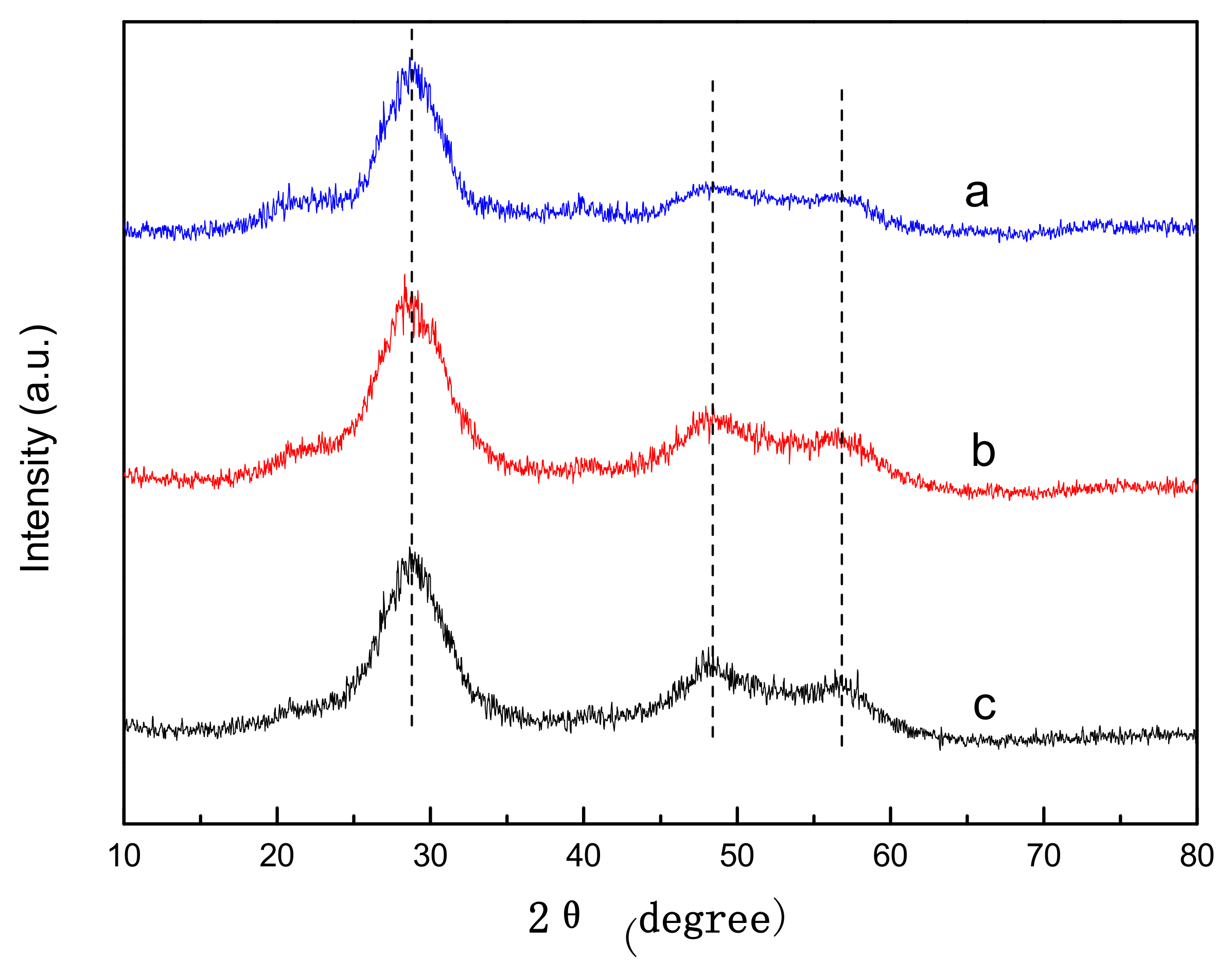
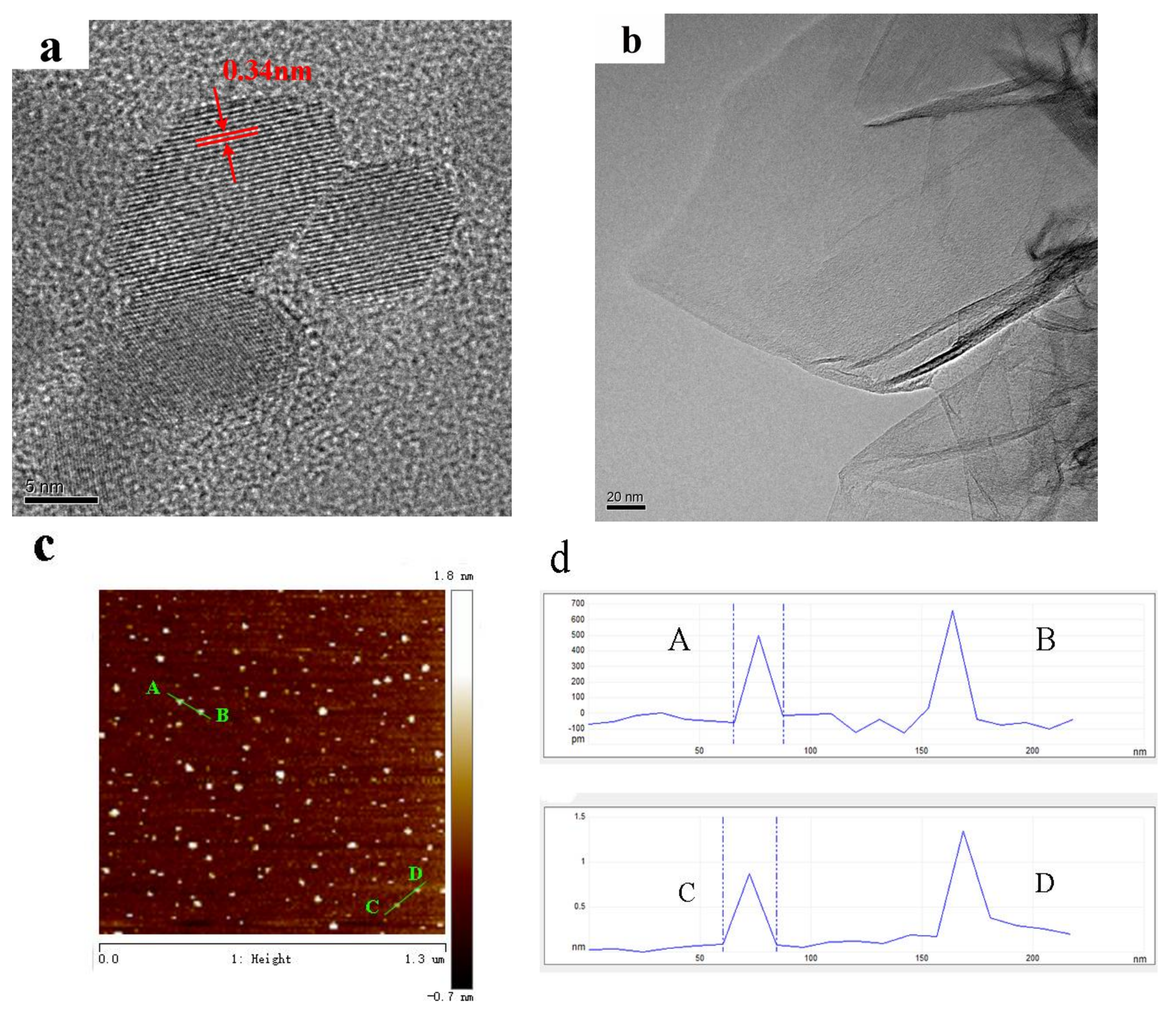
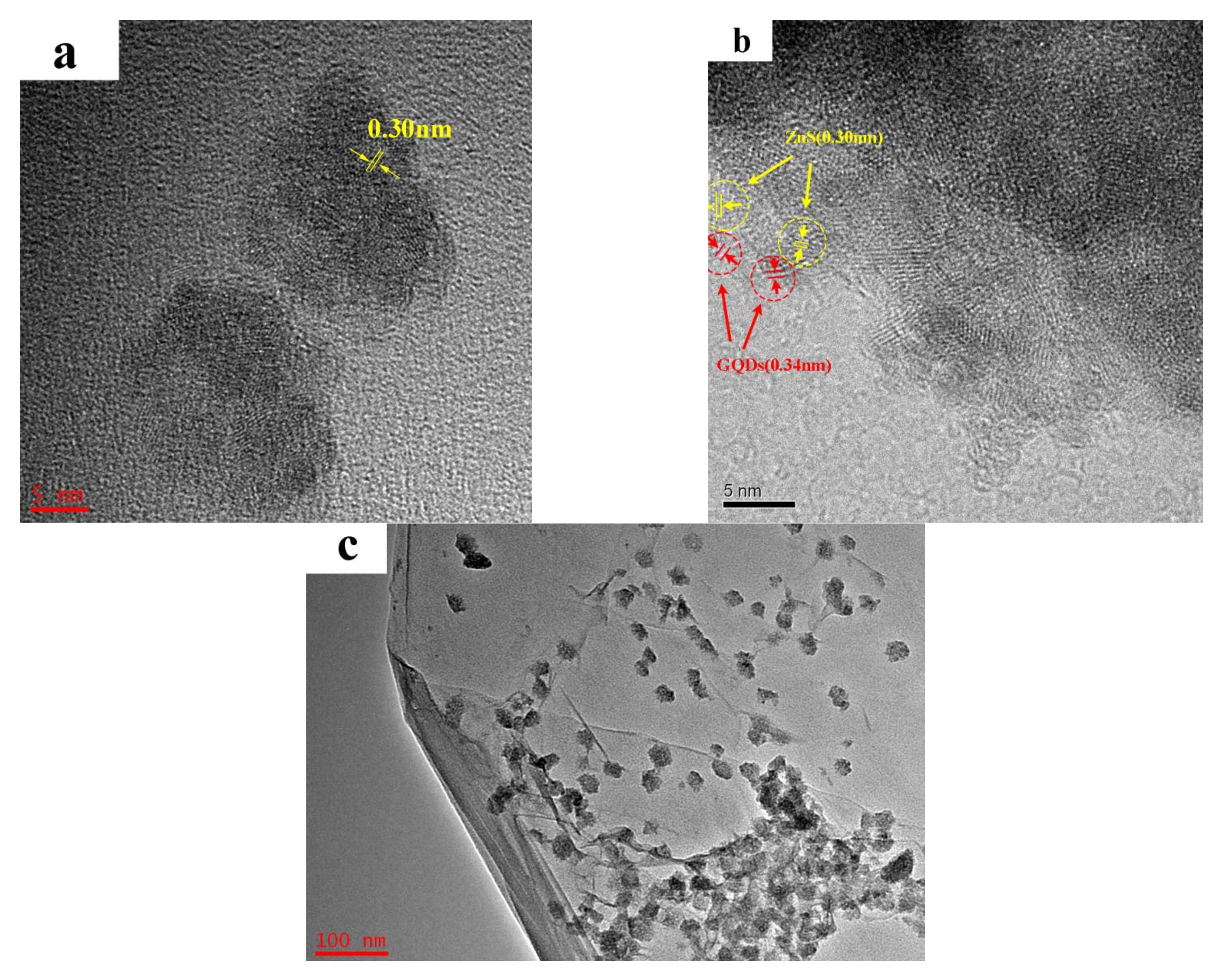


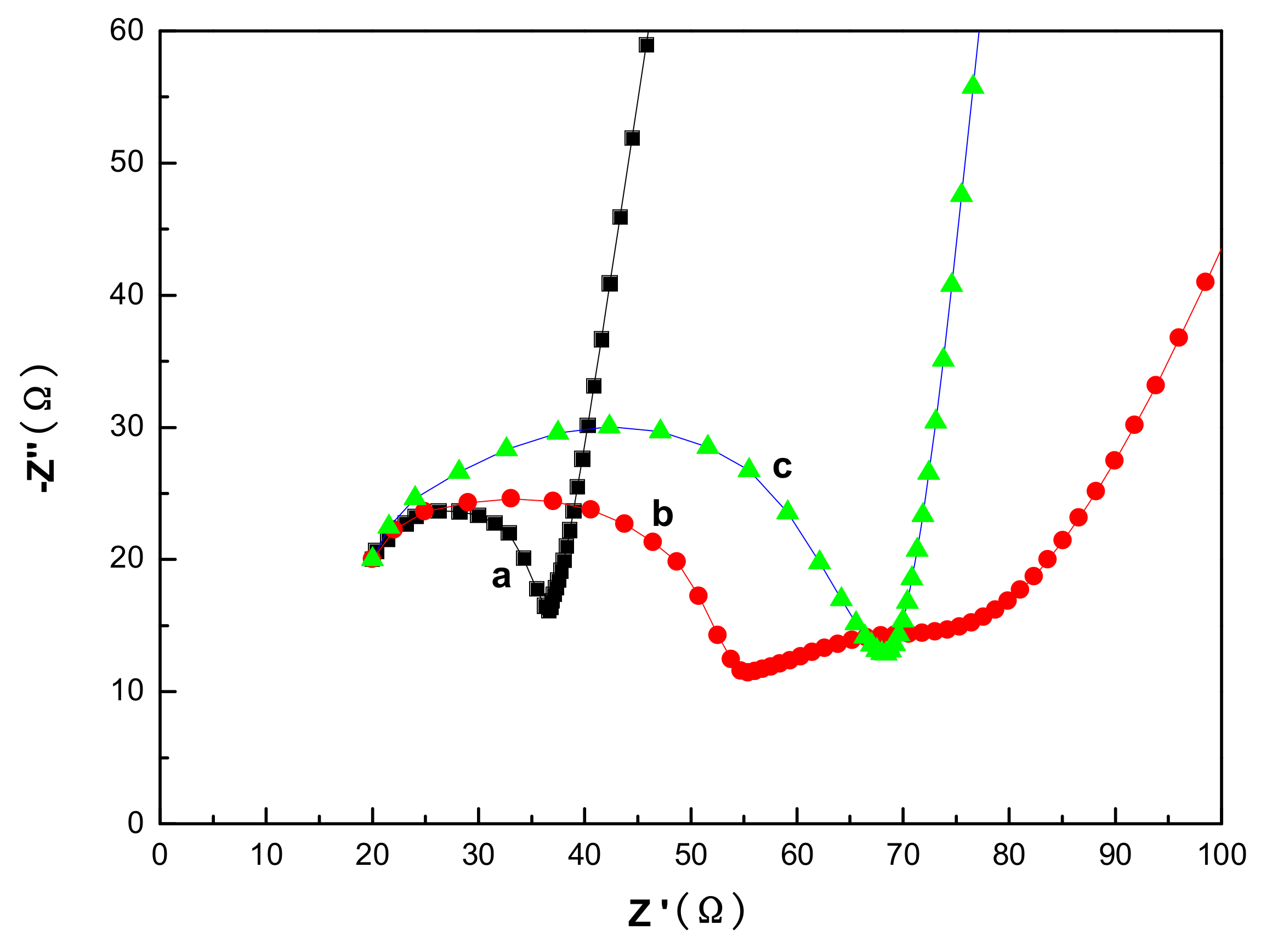
| Sample | ZnS-GQDs | ZnS-Graphene | ZnS |
|---|---|---|---|
| the photocurrent density (A/cm2) | 2.32 × 10−5 | 0.97 × 10−5 | 0.13 × 10−6 |
© 2018 by the authors. Licensee MDPI, Basel, Switzerland. This article is an open access article distributed under the terms and conditions of the Creative Commons Attribution (CC BY) license (http://creativecommons.org/licenses/by/4.0/).
Share and Cite
Zhang, Z.; Fang, C.; Bing, X.; Lei, Y. Graphene Quantum Dots-ZnS Nanocomposites with Improved Photoelectric Performances. Materials 2018, 11, 512. https://doi.org/10.3390/ma11040512
Zhang Z, Fang C, Bing X, Lei Y. Graphene Quantum Dots-ZnS Nanocomposites with Improved Photoelectric Performances. Materials. 2018; 11(4):512. https://doi.org/10.3390/ma11040512
Chicago/Turabian StyleZhang, Zheng, Chengyi Fang, Xin Bing, and Yun Lei. 2018. "Graphene Quantum Dots-ZnS Nanocomposites with Improved Photoelectric Performances" Materials 11, no. 4: 512. https://doi.org/10.3390/ma11040512




